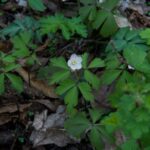wood anemone
Anemone quinquefolia

Description:
Anemone quinquefolia is a perennial herb that typically grows to be about 6-12 inches tall. The plant has delicate, white or pink flowers that bloom in the spring. Each flower has 5-20 petals that are 1-2 cm in diameter. The flowers are held on slender stalks above the leaves and bloom from April to June. The leaves are glossy, green, and deeply lobed, with 3-5 lobes. The leaves emerge from the base of the plant and are arranged in a basal rosette.
Anemone quinquefolia is native to North America and can be found growing in a variety of habitats, including woodlands, along streams, and in other damp locations. It prefers shaded or partially shaded areas and grows well in well-drained, moist soils. It can be found in the wild from Newfoundland to the Northwest Territories and south to the mountains of Georgia and Arizona. It is common in the woodlands across Wisconsin.
Details:
wood anemone
| USDA Symbol: | Common Name: | Scientific Name: |
|---|---|---|
| ANQU | wood anemone | Anemone quinquefolia |
ITIS TSN: 18448
Category: Dicot
Taxonomy
Kingdom: Plantae
Subkingdom:
Super Division: Spermatophyta
Division: Magnoliophyta
Subdivision:
Class: Magnoliopsida
SubClass: Magnoliidae
Order: Ranunculales
Family: Ranunculaceae
Counties: Adams, Ashland, Barron, Bayfield, Brown, Buffalo, Burnett, Calumet, Chippewa, Clark, Columbia, Crawford, Dane, Dodge, Door, Douglas, Dunn, Eau Claire, Florence, Fond du Lac, Forest, Grant, Green, Green Lake, Iowa, Iron, Jackson, Jefferson, Juneau, Kenosha, Kewaunee, La Crosse, Lafayette, Langlade, Lincoln, Manitowoc, Marathon, Marinette, Marquette, Menominee, Milwaukee, Monroe, Oconto, Oneida, Outagamie, Ozaukee, Pepin, Pierce, Polk, portageprice, Racine, Richland, Rock, Rusk, Sauk, Sawyer, Shawano, Sheboygan, St. Croix, Taylor, Trempealeau, Vernon, Vilas, Walworth, Washburn, Washington, Waukesha, Waupaca, Waushara, Winnebago, Wood
| Duration: | Growth Habit: | Native Status: |
|---|---|---|
| Perennial | Forb/herb | L48(N)CAN(N) |
| NR40 Listed Plant | Noxious Weed: | Invasive Species (NR40): | Threatened/Endangered: | WI Natural Heritage Index: | Wetland Status |
|---|---|---|---|---|---|
| FAC;FACU |
Carbon to Nitrogen Ratio:
Conspicuous Fall Color:
Flower Color: White
Conspicuous Flower: Yes
Foliage Light Porosity Summer:
Height at Base Age (Max):
Known Alelopath: No
Re-sproutability:
Shape and Orientation: Erect
Height (min): 12
Height (max): 24
Leaf Type:
Leaf Arrangement:
Leaf Shape: pinnatisect
Vein Pattern:
Adapted to Coarse Textured Soils:
Adapted to Medium Textured Soils:
Adapted to Fine Textured Soils:
Cold Stratification Required: Yes
Moisture Use: Medium
pH (Minimum): 5.0
pH (Maximum): 6.0
Planting Density per Acre, Minimum:
Planting Density per Acre, Maximum:
Precipitation (Minimum):
Precipitation (Maximum):
Root Depth, Minimum (inches):
Shade Tolerance: Tolerant
Plant Spacing (min): 12
Plant Spacing (max): 18
| Bloom Period: | Commercial Availability: | Fruit/Seed Abundance: |
|---|---|---|
| Mid Spring, Late Spring, Early Summer, Mid Summer | Routinely Available | Low |
| Fruit/Seed Period Begin: | Fruit/Seed Period End: | Fruit/Seed Persistence: |
|---|---|---|
| Propogated by Bare Root: | Propogated by Bulbs: | Propogated by Container: |
|---|---|---|
| No | No | Yes |
| Propogated by Corms: | Propogated by Cuttings: | Propogated by Seed: |
|---|---|---|
| No | No | Yes |
| Propogated by Sod: | Propogated by Sprigs: | Propogated by Tubers: |
|---|---|---|
| No | No | Yes |
| Seeds per Pound: | Seed Spread Rate: | Seedling Vigor: |
|---|---|---|
| 272000 |
| Small Grain: | Vegetative Spread Rate: | Propagation Treatment: |
|---|---|---|
| No | Moist Stratification |
| Days to Stratify: | Direct Sowing Time: |
|---|---|
| Early Spring, Spring |
Benefits: Deer Resistant, Pollinators
| Berry/Nut/Seed Product: | Christmas Tree Product: | Fodder Product: |
|---|---|---|
| No | No | No |
| Fuelwood Product: | Lumber Product: | Naval Store Product: |
|---|---|---|
| No | No | No |
| Nursery Stock Product: | Palatable Browse Animal: | Palatable Graze Animal: |
|---|---|---|
| Yes | -- | -- |
| Palatable Human: | Post Product: | Protein Potential: |
|---|---|---|
| No | No | -- |
| Pulpwood Product: | Veneer Product: |
|---|---|
| No | No |
| Benefits: | Wildlife Food Value: | Wildlife Cover Value: |
|---|---|---|
| Deer Resistant, Pollinators |
References:
- Lady Bird Johnson Wildflower Center Database – Anemone quinquefolia
- USDA Plants Database – Anemone quinquefolia
- Wisflora Database – Anemone quinquefolia
Return to Native Plants page
